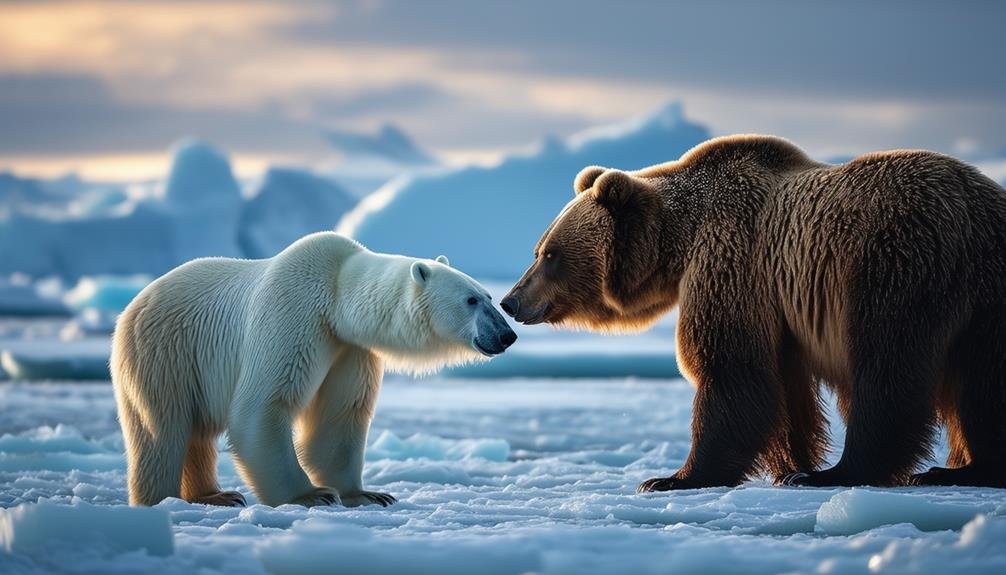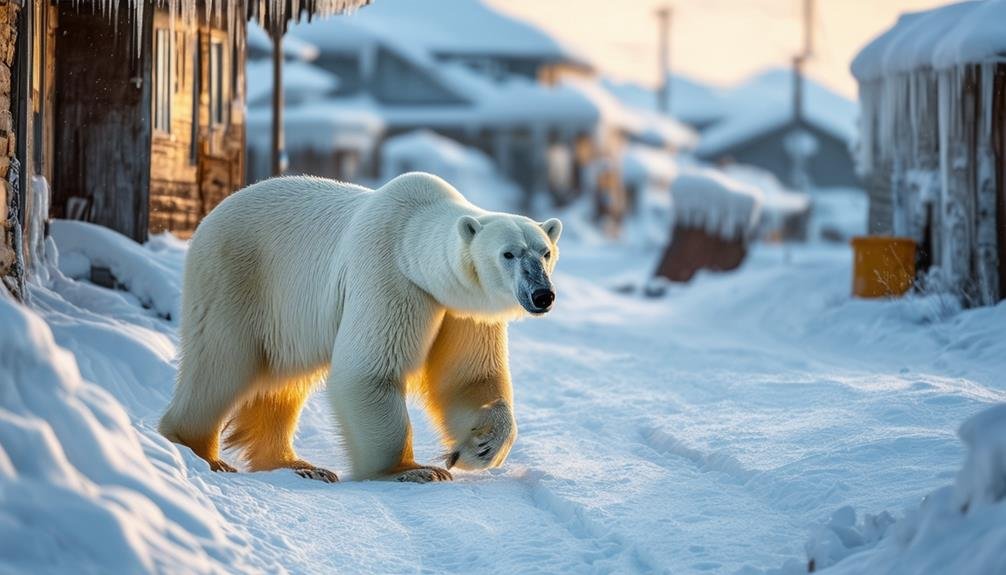Polar bears are adapting to climate change through several key behaviors. They are
diversifying their diet to include plants and bird eggs, a shift essential due to diminishing sea ice.
Increased time on land is observed, as prolonged ice-free periods challenge their habitat and food availability.
Interbreeding with grizzlies results in hybrid offspring, enhancing genetic diversity.
Smaller cub births serve as a survival mechanism during prolonged fasting periods caused by habitat loss. Additionally, polar bears are increasingly
exploring human settlements for food, posing challenges for conservation. Each adaptation illustrates their resilience in a rapidly changing environment, shedding light on surprising survival strategies.
Main Points
- Polar bears are diversifying their diet to include plants, bird eggs, and whale carcasses.
- They are spending more time on land due to prolonged ice-free periods.
- Interbreeding with grizzlies results in hybrid ‘pizzly’ bears with adaptive traits.
- Smaller cub births are an adaptation to limited food availability and prolonged fasting.
- Increased foraging in human settlements occurs as a response to habitat loss.
Changing Dietary Habits
As climate change continues to alter their
Arctic habitat, polar bears are adapting by
diversifying their diet to include more plants and bird eggs. This
significant shift in dietary habits is essential for their survival as sea ice, their
primary hunting ground, becomes increasingly scarce. Polar bears have traditionally relied on seals for sustenance, but the changing environment necessitates
alternative food sources.
Incorporating plants and bird eggs into their diet allows polar bears to sustain themselves during extended fasting periods when access to seals is limited. These new dietary habits help them maintain their
energy reserves, which is crucial for their overall health and survival. Additionally, some polar bears have been observed consuming whale carcasses, further exemplifying their adaptability and resilience in the face of habitat loss.
Increased Time on Land
Shifting dietary habits are not the only adjustment polar bears are making; they are also spending much more time on land due to the prolonged ice-free periods in regions like western
Hudson Bay. This change is a direct reaction to the increasing length of ice-free periods, which have extended by three weeks between 1979 and 2015.
As polar bears adapt to these habitat shifts, they face several challenges:
- Food scarcity: With limited access to their main prey, seals, during sea-ice free periods, polar bears struggle to find adequate nutrition on land.
- Increased time on land: Currently, polar bears in western Hudson Bay spend an average of 130 days on land each year, with projections indicating an additional 5 to 10 days per decade.
- Survival: The prolonged duration on land has contributed to a 30% decline in the polar bear population in western Hudson Bay since 1980.
- Habitat changes: The shift from sea ice to terrestrial environments demands significant adaptation in behavior and physiology.
- Climate change: The overarching driver of these changes continues to pose existential threats, necessitating ongoing adjustments for survival.
Interbreeding With Grizzlies
In response to
shrinking sea ice and
habitat loss,
polar bears have begun interbreeding with
grizzly bears, resulting in hybrid offspring known as ‘pizzly’ or ‘grolar’ bears. This interbreeding phenomenon is a notable adaptation to the changing habitats driven by climate change. As the Arctic environment undergoes significant shifts, polar bears are increasingly encountering grizzly bears in
overlapping territories. The hybrid offspring produced from these unions possess a mix of traits from both parent species, potentially equipping them with enhanced abilities to cope with evolving environmental conditions.
The interbreeding between polar bears and grizzly bears introduces new
genetic diversity, which may offer
adaptive advantages in the face of habitat loss and other
climate-induced challenges. Genetic diversity is essential for the survival of species, as it enables a broader range of responses to environmental stressors. These hybrid bears may display traits that allow them to thrive in more varied and less predictable conditions compared to their purebred counterparts.
Ultimately, hybridization represents a natural response to the pressures exerted by climate change, showcasing the resilience and adaptability of wildlife. As environmental conditions continue to evolve, interbreeding may play an increasingly significant role in the
survival strategies of polar bears.
Smaller Cub Births
Polar bear mothers are increasingly giving birth to smaller cubs, an adaptation that enhances the cubs’ chances of surviving prolonged fasting periods caused by diminishing sea ice. This strategic shift is a response to the changing environments and the myriad challenges posed by climate change. Smaller cubs are better equipped to endure extended periods without food, a direct consequence of limited food availability due to shrinking sea ice habitats. This adaptation is vital for the survival of polar bear populations facing the harsh realities of their melting arctic home.
Key aspects of this adaptation include:
- Increased chances of survival: Smaller cubs have a higher likelihood of surviving extended fasting periods.
- Limited food availability: The reduction in sea ice has led to a decrease in accessible prey.
- Changing environments: As habitats shrink, polar bears must adapt to new environmental pressures.
- Resilience: The birth of smaller cubs is a proof of the species’ ability to adjust to climate-induced changes.
- Insight into population dynamics: Understanding this trend provides valuable information on how polar bears may continue to cope with climate change.
These smaller births are a vital survival mechanism, highlighting the resilience of polar bears in the face of ongoing environmental transformations.
Navigating Human Settlements
As
climate change continues to impact their
natural habitat, polar bears increasingly venture into human settlements in search of sustenance. This behavior is a direct response to
habitat loss, as prolonged ice-free periods limit their traditional hunting grounds. As a result, polar bears have begun to adapt by
foraging in human settlements, where alternative food sources can be found. This shift in their behavior highlights the substantial challenges posed by climate change.
The increased interactions between polar bears and humans raise important
conservation concerns. The proximity of these
apex predators to populated areas not only endangers
human safety but also complicates efforts to protect the bears. Conservationists are particularly worried about the potential for conflict, as these interactions can lead to
harmful encounters for both humans and bears.
Furthermore, foraging in human settlements is not a sustainable long-term adaptation for polar bears. The
nutritional quality and availability of food in these areas differ significantly from their natural diet, potentially impacting their health. Addressing the root causes of habitat loss and mitigating climate change are essential steps to reduce the pressures on polar bears and ensure their survival in the wild.
How Are Polar Bears Adapting to Climate Change Over Time and Through Different Challenges?
Polar bears are facing numerous challenges due to the rapid loss of sea ice, a critical hunting ground. Over time, polar bears’ climate adaptation has involved longer swims, scavenging on land, and altered migration patterns as they struggle to survive in a warming Arctic. Their survival is increasingly uncertain.
Conclusion
Polar bears exhibit notable adaptability in response to climate change through altering
dietary habits,
spending increased time on land,
interbreeding with grizzlies, experiencing
smaller cub births, and maneuvering human settlements. These behavioral and physiological changes highlight the species’ resilience, yet also underscore the challenges posed by a rapidly changing environment. Continued observation and research are essential to understand the long-term implications of these adaptations and to inform conservation efforts aimed at preserving polar bear populations.




